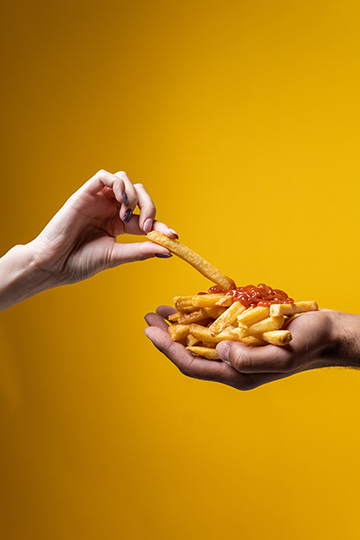Eat Right, Live Strong
The goal of Team Worx in Alexandria, VA, is to help you live strong. That takes a program of regular exercise. It also requires adequate hydration, quality sleep, and learning to eat right. We can help you master two with an exercise program that transforms your body and nutrition coaching that speeds the process. Eating right means giving your body the macro and micronutrients it needs to feel and be your best.
Eat more healthy options and avoid unhealthy ones.
When you eat unhealthy food, like food high in added sugar or fat, it triggers the release of dopamine and opioids in the brain. These feel-good hormones have the addictive nature of opioids. The more sugar and fat you eat, the more you want. Like any addiction, it takes an increasing amount to trigger the pleasure hormones. Food with added sugar causes weight gain and affects your heart and kidneys. It damages collagen and causes wrinkles. If the food has high fructose corn syrup, a highly processed sweetener, it affects your ghrelin—hunger hormone—and leptin—your satiety hormone. It creates an empty pit of hunger you can never fill.
Choosing highly processed foods introduces chemicals and unnaturally high sodium levels into the body.
If you read food labels, you’ll notice highly processed food often has ingredients that sound like a chemistry experiment. If you can’t pronounce the additives, don’t eat the food. Not all processing is unhealthy. Washing produce makes it processed. The food that doesn’t resemble anything found in nature causes problems. Consider Cheetos, one of my guilty pleasures. There’s nothing natural about them. They’re high in fat and sodium. They contain maltodextrin. The FDA doesn’t require the manufacturer to label it sugar, yet the glycemic index is twice as high as table sugar even though the label shows zero grams of sugar. It’s no wonder it’s hard to stop eating them.
Stay focused on eating more whole foods.
Fill your plate with a colorful salad, baked salmon, fresh steamed broccoli, and a potato mash made with steamed carrots, cauliflowers, and potatoes. It’s delicious and far healthier than eating a burger and fries. This meal is a rainbow of colors from vegetables. Phytonutrients in vegetables give them their color, so the more colors you include, the wider the variety of nutrients. Choosing meals like this can help you get fit faster.
- Including high-fiber food in your diet helps keep blood glucose levels even. It feeds the beneficial microbes in your digestive system to keep you healthier and helps keep you regular.
- Live strong by hydrating regularly. Drinking water frequently helps. Avoid soft drinks. Studies show a link between diet soft drinks and belly fat. If you don’t like plain water, try infused water.
- Include all types of exercise in your workout. Your body needs flexibility, strength, cardio, and balance training. Flexibility training and balance training are often overlooked but can prevent injury.
- Exercising regularly also plays a vital role in another healthy lifestyle change. It helps you sleep better. Adequate sleep is necessary for heart health. When you sleep, your brain reorganizes information, and your body heals injuries.
For more information, contact us today at Team Worx Fitness










